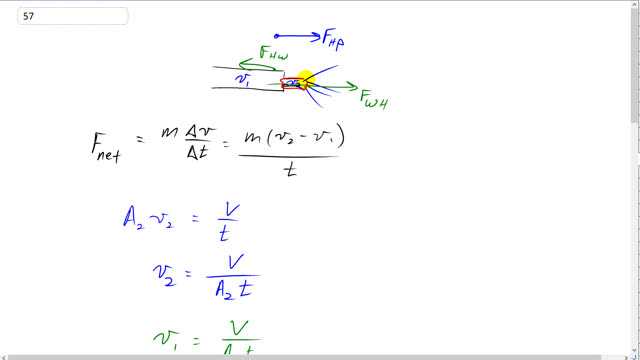
A fire hose exerts a force on the person holding it. This is because the water accelerates as it goes from the hose through the nozzle. How much force is required to hold a 7.0-cm-diameter hose delivering 420 L/min through a 0.75-cm-diameter nozzle?

In order to watch this solution you need to have a subscription.
This is Giancoli Answers with Mr. Dychko. In order for the water to speed up as it goes from the large diameter section of hose and then into the small diameter nozzle— it's going to go faster in the nozzle. In order for that speedup to happen, there has to be a net force applied in order to change that speed. And net force we know is mass times acceleration and acceleration is change in speed over change in time and so net force is mass times v 2 minus v 1 over time. Now this net force on the water is gonna be the force on the water due to the hose and there's gonna in turn be a Newton's third law counterpart to that— the force on the hose due to the water— and that's gonna be backwards and so a person holding the hose has to put a force on the hose due to the person going forwards and so all of these forces shown here are of equal magnitude. And so when we calculate the force that's needed to be exerted on the water, which is what we'll do, that's gonna also be the force that's on the hose due to the person. So here we are, there's lots of stuff we don't know in this formula: we don't know v 2 and v 1 and we don't even know m and so what we do know though is the volume rate of flow and we know some diameters so let's express as much as we can in terms of diameters or areas—that'll work too— and volume. So we know the equation of... well, I was gonna say equation of continuity although it's not really that important. The volume rate of flow formula says that the area of the pipe times the speed of the fluid through it is the volume rate of flow, the volume per second or volume per time and we can solve for v 2 in this equation by dividing both sides by A 2 and we get v 2 is volume divided by A 2 times time. And that's useful because we know the volume rate of flow, V over t, and we can calculate the area of the nozzle as well since we know it's diameter. And then the same line of thinking tells you v 1 that's the volume divided by A 1 times t and we can even express the mass in terms of volume by saying it's the water's density times the volume. So make substitutions for each of those things on the next line here and so we have mass is replaced by ρV and v 2 is replaced by V over A 2 times t and v 1 is replaced by V divided by A 1 times t all that's divided by t still because that's what the formula says there and I could have done this in one step but I did it in two just to try and be more clear so let's distribute this term into the brackets here, or this factor I should say, distribute this factor into the brackets there by multiplying both things by it and so we have ρ times V squared and then for both the terms and then divide by A 2 times t squared minus ρV squared over A 1 times t squared and the t squared is there because, you know, multiply top and bottom by 1 over t and so on the bottom, it just becomes 1 and on the top, we end up with this stuff over t getting multiplied by 1 over t which makes the t squared on the bottom. And there are lots of common factors there that we can factor out so we have ρV squared over t squared times by 1 over A 2 minus 1 over A 1 and A 2 is diameter over 2 which is the radius squared times π and A 1 is diameter 1 over 2 which is radius squared times π and then we can plug in numbers to get our answer. So we have density of water—1.00 times 10 to the 3 kilograms per cubic meter— times 420 liters converted into meters cubed by multiplying by 1.0 times 10 to the minus 3 cubic meters per liter and we square that volume and divide by the amount of time here during which you get 420 liters which is one minute which we convert into seconds by multiplying by 60 seconds per minute and then square that time and then multiply by 1 over π times the nozzle diameter 0.75 expressed in meters so it's times 10 to the minus 2 meters over 2 and then square that minus 1 over π times 7.0 times 10 to the minus 2 over 2 squared. In the calculator, it looks like this and be careful with the bracket matching particularly in this part here, we have 1 divided by π times 0.75 times 10 to the minus 2 over 2 squared; this bracket here... when I first did this, I forgot this little bracket here that has to close this bracket here and then there you go! So we have 1100 newton is approximately how much force would be needed to apply on the hose to keep it stationary.